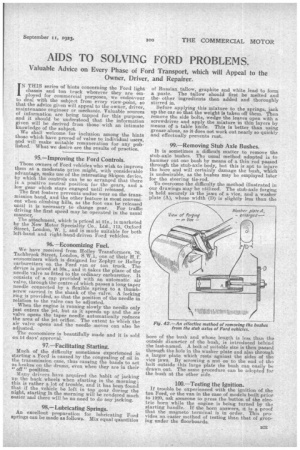AIDS TO SOLVING FORD PROBLEMS.
Page 25

If you've noticed an error in this article please click here to report it so we can fix it.
Valuable Advice on Every Phase of Ford Transport, which will Appeal to the Owner, Driver, and Repairer.
IN THIS series of hints concerning the Ford light chassis and ton truck wherever they are employed for commercial purposes, we endeavour to deal with the subject from every view-point, so that the advice given will appeal to the owner, driver, maintenance engineer or mechanic. Valuable sources of information are being tapped for this purpose, and it should be understood that the information given will be derived from those with an intimate knowledge of the subject.
We shall welcome for inclusion among the hints those which have proved of value to individual users, and will make suitable remuneration for any published. What we desire are the results of practice.
95.—Improving the Ford Controls.
Those owners of Ford vehicles who wish to improve them at a moderate price might, with considerable advantage, make use of the interesting Skipon device, by which the controls can be so arranged that there is a positive neutral position for the gears, and a low gear which stays engaged until released.
The first feature prevents undue wear on the transmission band, and the other feature is most convenient when climbing hills as the foot can be released until it is nee,essary to change gear. For traffic driving the first speed may be operated in the usual manner.
The attachment, which is priced at 21s., is marketed by the New Motor Speciality Co., Ltd.' 113, Oxford Street, Landon, W. 1, and is made suitable for both left-hand and right-hand-driven Ford vehicles.
96.--Economizing Fuel.
We have received from Holley Transformers, 76, Tachbrook Street, London, S.W.1, one of their H.T. economizers which is designed for Zephyr or Holley carburetters on the Ford van or ton truck. The device is priced at 30s., and it takes the place of the needle valve as fitted to the ordinary carburetter. It consists of a cap provided with an automatic air valve, through the centre of which passes a long taper needle connected by a flexible spring to a thumbscrew carried in the shank of the valve. A locking ring is provided, so that the position of the needle in relation to the valve can be adjusted.
When the engine is running slowly the needle only just enters the jet, but as it speeds up and the air valve opens the taper needle automatically reduces the area of the jet orifice. The extent to which the air valve opens and the needle moves can also be adjusted.
The economizer is beautifully made and it is sold on 14 days' approval.
97.—Facilitating Starting.
Much of the difficulty sometimes experienced in starting a Ford is caused by the congealing of oil in the transmission case, thus causing the bands to act as brekes on the drums, even when they are in their " off " position.
Many drivers have acquired the habit of jacking up the back wheel when starting in the morning; this is rather a lot of trouble, and it has been'found that if the vehicle be left in top gear during the night, starting in the morning will be rendered much easier and there will be no need to do any jacking.
98.—Lubricating Springs.
An excellent preparation for lubricating Ford springs can be made as follows. Mix equal quantities
of Russian tallow, graphite and white lead to form a paste. The tallow should first be melted and the other 'ingredients then added and thoroughly stirred in.
Before applying this mixture to the springs, ja,ck up the car BO that the weight is taken off them. Then remove the side bolts, wedge the leaves open with a screwdriver and apply the mixture in thin layers by means of a table knife. This is better than using grease alone, as it does not work out nearly so quickly and effectually prevents rust.
99.—Removing Stub Axle Bushes.
It is sometimes a difficult matter to remove the stub-axle bushes. The usual method adopted is to hammer out one bush by means of a thin rod passed through the stub-axle body, but this is apt to injure the bore and will certainly damage the bush, which is undesirable, as the bushes may be employed later for the steering tie-rod. To overcome the difficulty the method illustrated in our drawings may be utilized. The stub-axle forging is held securely in the jaws of a vice, and a washer plate (A), whose width (D) is slightly less than the
bore of the hush and whose length is less than the outside diameter of the bush, is introduced behind the last-named. A bolt of suitable size is then passed through the hole in the washer plate and also through a larger plate which rests against the sides of the vice jaws. By screwing a nut. on to the end of the bolt outside this large plate the bush can easily be drawn out. The same procedure can be adopted for the bush at the other side.
100.—Testing the Ignition.
If trouble be experienced with the ignition of the ton Ford, or the van in the case of models built prior to 1920, ask someone to press the button of the electric horn while the engine is being turned by the starting handle. If the horn answers, it is a proof that the magneto terminal is in order. This provides an. easier method of testing than that of groping under the floorboards.


































